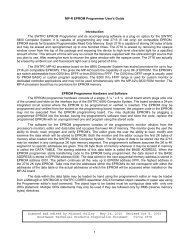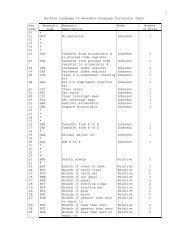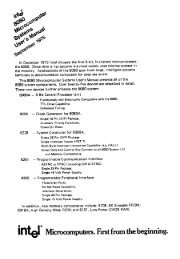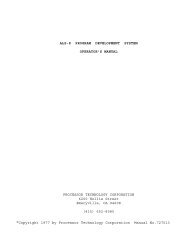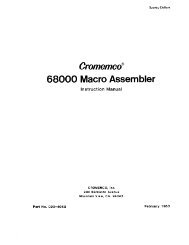The System Manual of SOL-20 - History of Computers
The System Manual of SOL-20 - History of Computers
The System Manual of SOL-20 - History of Computers
Create successful ePaper yourself
Turn your PDF publications into a flip-book with our unique Google optimized e-Paper software.
PROCESSOR TECHNOLOGY CORPORATION<br />
Sol THEORY OF OPERATION<br />
SECTION VIII<br />
Fused primary power is applied through S5 to T1 (T2 in the<br />
Sol-<strong>20</strong>). FWB1, a full-wave bridge rectifier, is connected across<br />
the 8-volt secondary (green leads). <strong>The</strong> rectified output is filtered<br />
by C8 and applied to the collector <strong>of</strong> Q1. Q1, a pass transistor, is<br />
driven by Q2, with the two connected as a Darlington pair. <strong>The</strong> output<br />
<strong>of</strong> Q1 is connected to R1 which serves as an overload current<br />
sensor.<br />
An overload current (approximately 4 amps) increases the<br />
voltage drop across R1. <strong>The</strong> difference is amplified in one-half <strong>of</strong><br />
U2 (an operational amplifier) and the output on pin 7 turns Q3 on.<br />
Q3 in turn "steals" current from Q1-Q2 and diverts current from the<br />
output on pin 1 <strong>of</strong> U2. This in effect turns the supply <strong>of</strong>f to reduce<br />
the current and voltage. Note that the circuit is not a constant<br />
current regulator since the current is "folded back" by R6 and R8.<br />
<strong>The</strong> current is reduced to about 1 amp as the output voltage falls<br />
to zero.<br />
Divider network R11 and R12, which is returned to -12 volts,<br />
senses changes in the output voltage. If the output voltage is 5<br />
volts, the input on pin 2 <strong>of</strong> U2 is at zero volts. U2 provides a<br />
positive output on pin 1 if pin 3 is more positive than pin 2 and a<br />
negative output for the opposite condition.<br />
When the output voltage falls below 5 volts, pin 2 <strong>of</strong> U2<br />
goes more negative than pin 3. This means pin 1 <strong>of</strong> U2 goes positive<br />
to supply more current to the base <strong>of</strong> Q1. <strong>The</strong> resulting increase<br />
in current to the load causes the output voltage to rise<br />
until it stabilizes at 5 volts. Should the output voltage rise above<br />
5 volts, the circuit operates in a reverse manner to lower the<br />
voltage.<br />
Protection against a serious over-voltage condition (more<br />
than 6 volts) is provided by SCR1, D1, R2, R13, R14 and C8. Zener<br />
diode, (D1), with a 5.1 zener voltage, is connected in series with<br />
R13 and R2. When the output voltage exceeds about 6 volts, the resulting<br />
voltage drop across R2 triggers SCR1 to short the foldback<br />
current to ground. Since the overload current circuit is also working,<br />
the current through SCR1 is about 1 amp. Once the current is<br />
removed, this circuit restores itself to its normal condition; that<br />
is, SCR1 turns <strong>of</strong>f. R13, R14 and C8 serve to slightly desensitize<br />
the circuit so that it will not respond to small transient voltage<br />
spikes.<br />
Bridge rectifier FWB2, connected across the other T1 secondary,<br />
supplies +12 and -12 V dc. <strong>The</strong> positive output <strong>of</strong> FWB2 is filtered<br />
by C5 and regulated by IC regulator U1. <strong>The</strong> negative output<br />
is filtered by C4 and regulated by U3. Shunt diodes D3 and D4 protect<br />
U1 and U3 against discharge <strong>of</strong> C6 and C7 when power is turned<br />
<strong>of</strong>f. (Note that should the -12 volt supply short to ground, the<br />
+5 volt supply turns <strong>of</strong>f by the action <strong>of</strong> U2.<br />
VIII-7



